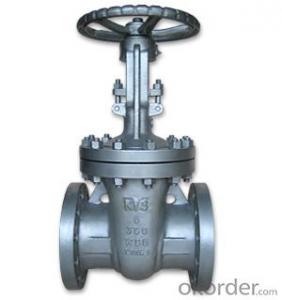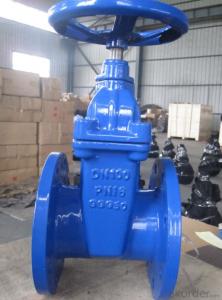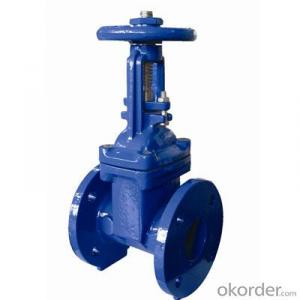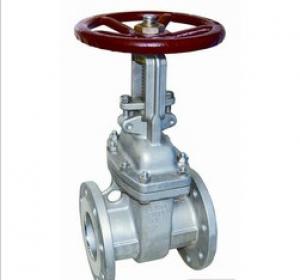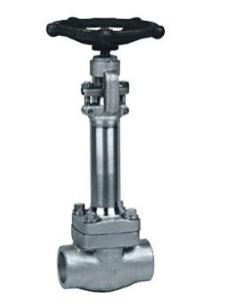Gate Valve Non-rising Stem with Best Price and High Quality
- Loading Port:
- Tianjin
- Payment Terms:
- TT OR LC
- Min Order Qty:
- 100 pc
- Supply Capability:
- 10000 pc/month
OKorder Service Pledge
OKorder Financial Service
You Might Also Like
1.Structure of Gate Valve Description:
A gate valve, also known as a sluice valve, is a valve that opens by lifting a round or rectangular gate/wedge out of the path of the fluid. The distinct feature of a gate valve is the sealing surfaces between the gate and seats are planar, so gate valves are often used when a straight-line flow of fluid and minimum restriction is desired. The gate faces can form a wedge shape or they can be parallel. Gate valves are primarily used to permit or prevent the flow of liquids, but typical gate valves shouldn't be used for regulating flow, unless they are specifically designed for that purpose. Because of their ability to cut through liquids, gate valves are often used in the petroleum industry. For extremely thick fluids, a specialty valve often known as a knife valve is used to cut through the liquid. On opening the gate valve, the flow path is enlarged in a highly nonlinear manner with respect to percent of opening. This means that flow rate does not change evenly with stem travel. Also, a partially open gate disk tends to vibrate from the fluid flow. Most of the flow change occurs near shutoff with a relatively high fluid velocity causing disk and seat wear and eventual leakage if used to regulate flow. Typical gate valves are designed to be fully opened or closed.When fully open, the typical gate valve has no obstruction in the flow path, resulting in very low friction loss.
2. Main Features of the Gate Valve:
• Valve body cavity using non-toxic epoxy resin,both inside and outside flashboard completely is coated with rubber
• Free of water pollution
• High manufacturing accuracy
• High strength
• Environmental protection and energy saving
• Good visual effect
3. Images

4. Gate valve Specification
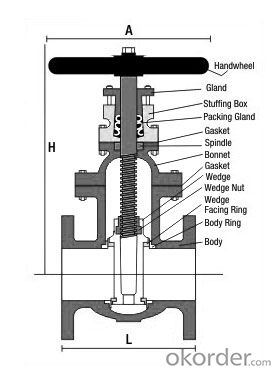

5.FAQ
1. What's are the characteristics of gate valve?
The distinct feature of a gate valve is the sealing surfaces between the gate and seats are planar, so gate valves are often used when a straight-line flow of fluid and minimum restriction is desired. The gate faces can form a wedge shape or they can be parallel.
2. What is the work principle of gate valve ?
The gate faces can form a wedge shape or they can be parallel. Gate valves are primarily used to permit or prevent the flow of liquids, but typical gate valves shouldn't be used for regulating flow, unless they are specifically designed for that purpose. Because of their ability to cut through liquids, gate valves are often used in the petroleum industry.
3. What is the structure?
Bonnets provide leakproof closure for the valve body. Gate valves may have a screw-in, union, or bolted bonnet. Screw-in bonnet is the simplest, offering a durable, pressure-tight seal. Union bonnet is suitable for applications requiring frequent inspection and cleaning. It also gives the body added strength. Bolted bonnet is used for larger valves and higher pressure applications.
- Q: What is the soft seal gate valve?
- General soft sealing gate valve model is Z41X Ming bar. The dark pole is Z45X. They're all for hydraulic purposes
- Q: Valve flange drawing n- up to what
- A bolt hole used to indicate a flangeThe value of N indicates the number of bolt holesUp to the numerical representation of bolt hole size
- Q: What is the meaning of socket welding gate valve A105, D&S:STLT, STEM:13Cr, CL800, SW, AP1602, BB-BG-OS&Y?
- Body material: A105Sealing surface material: STLStem material: 13CrPressure rating: CL800Connection: SWImplementation criteria: AP1602BB-BG-OS&Y: plain rod support, bolt connection, flange valve cap.
- Q: What does gate valve do?
- Like other valves, the gate valve is used to block fluid flow. Is the gate valve opening and closing parts, RAM direction of motion perpendicular to the direction of the fluid, valve can only be fully open and fully closed, can not be adjusted and the throttle.
- Q: What do you mean by forged steel gate valves 800LB DN20 SW?
- Is the forged steel gate 800LB is DN20 on SW welding pressure
- Q: Does the tap belong to a stop valve or a gate valve?
- Most faucets are stop valves,Part of the faucet is plug valve,Hot water nozzles are almost all plug valves.
- Q: What is the wedge type gate valve wedge is what mean
- It can be used on high pressure gate valve. Wedge gate and elastic wedge gate, gate and double gate. A, elastic ram. A circular groove is machined on the vertical bisector surface of the gate so that the gate plate has a certain elasticity. It is this elastic deformation, the gate is closed, the compensation gate sealing surface and the valve seat sealing surface between the wedge angle deviation, the arrival of good agreement, to ensure the sealing. Resilient gate valve sealing surface reliable. Applicable to a variety of pressure and temperature of small and medium-sized gate valve, requiring medium containing solid particles to less, in order to prevent congestion in the gate ring groove, affecting the flexibility of sealing.
- Q: What does valve qz45x - 10q mean?
- Crown valve pressWhat does Q stand for? I'm not sure. It's probably made of ductile iron"Z" means "gate valve"4 represents flange connection5 represents the dark bar (1 represents the Ming pole)X stands for rubber seal and soft seal10q stands for 10 pressure
- Q: What does the gate valve SZ45X-1.0 stand for?
- A modelModel SZ45T-1.0, especially in DN100 ~ DN300 piping, soft sealing gate valve shall be used
- Q: What is the size and length of the DN80 gate valve? 10 kg and 16 kg, respectively?
- Valve structure length standards are PN16, short series for 203mm, long series for 280mm, flange size by PN16.
Send your message to us
Gate Valve Non-rising Stem with Best Price and High Quality
- Loading Port:
- Tianjin
- Payment Terms:
- TT OR LC
- Min Order Qty:
- 100 pc
- Supply Capability:
- 10000 pc/month
OKorder Service Pledge
OKorder Financial Service
Similar products
Hot products
Hot Searches
Related keywords

